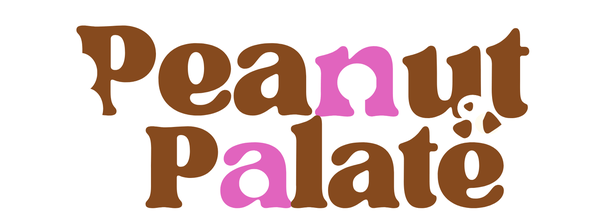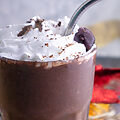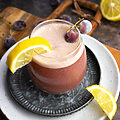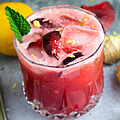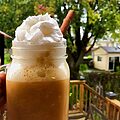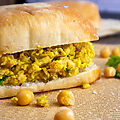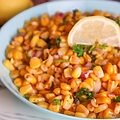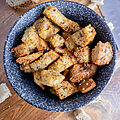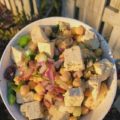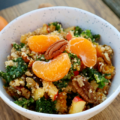
Raw Vegan Carrot Cake Recipe
Today we are making an easy Vegan Carrot Cake Recipe as a double layer cake: Carrot and Coconut! Not carrot cake with vegan cream cheese frosting, but not a tropical coconutty cake either. Plus, it’s almost all raw! Well, it’s no bake – you just have to use a food processor or blender for both layers, stack them on one another, and freeze! The bottom layer is a dense and filling carrot cake layer, with minimal nuts required too. Usually, raw vegan cakes use a ton of nuts, especially cashews for vegan cheesecakes!
So I call this that breath of fresh air cake that uses a base made of oats + a bit of walnuts instead. The walnuts can probably be substituted for more oats, if you’re allergic to all nuts. Also, nuts can be expensive. I do get called out by my mom for using heaping amounts of almonds, pecans, cashews, walnuts, and every type of nut that she brings home in the recipes I’ve been testing …
Best Vegan Carrot Cake?
What makes up the perfect vegan carrot cake? A thick layer of tangy cream cheese frosting, the inside filled with specks of freshly grated carrots, toasted walnuts on top (and perhaps within it) for that delicious crunch, a fluffy inside where the frosting sits gently on the cake layers as you press your fork down, a super soft middle with a golden-brown top … I could go on and on. But what about egg-free and dairy-free carrot cake? How can those turn out just as delicious?
Although that’s not the traditional carrot cake method, there are so many dairy and egg substitutes available now. For eggs, we’ve gone from using pureed bananas or apple sauce in brownie and muffin recipes, making a chia egg or flax egg (with chia seeds or flax seeds!), to making vegan buttermilk with lemon juice and almond milk to allow a cake to get fluffy without eggs.
As for dairy, there’s now coconut milk or coconut cream to replace heavy cream, vegan butter sticks, vegan milks and much more! The opportunities for substituting dairy and eggs are endless.
This isn’t even including raw cakes, which don’t need either of these, instead requiring a high-fat substitute to maintain creaminess (like cashews or full-fat coconut milk).
Today’s Recipe Inspiration
It took me about 20 minutes to blend this recipe togeher, and we used it as a birthday cake for my dad! The coconut cream was already prepared in the fridge, which reduced the time needed. Then I topped it with some shredded carrots, raisins, and flowers taken out of our garden. It was a gloomy day, so unlike my other pictures I’m not kneeling by a bed of bright white or red flowers in the background today …
I took some inspiration from another recipe here, then changed it up to make it carrot coconut! This recipe is also almost fully raw, but not quite. Why not? For one, the recipe uses oats. Raw oats undergo a process to make them digestible, which makes them not raw. Pure maple syrup also undergoes a series of processes before we use it, taking it off the raw list as well. Coconut cream has been processed to be added to a can, but if it were pure coconut cream made by a fresh coconut, it would really make raw coconut cream too.
Why You’ll Love This Vegan Carrot Cake Recipe
No Bake Vegan Spring Cake: This delicious vegan carrot cake is for that special occasion you’ve been waiting for! As far as vegan cake recipes go, I’ve been through too many to count. Every birthday, anniversary and anything in between was up to me to make a cake with less sugar for a healthier version to replace the traditional butter, sugar, flour and eggs based cakes.
This cake was the outcome of one of these birthdays! I love this recipe because it’s so rich in taste, due to the natural sugars and fat in the coconut cream, walnuts and dates, not to mention the other natural ingredients used in the recipe.
It’s also low-hassle. No turning on the oven, no toasting anything on the stovetop, barely any dishes to clean. Which also means there’s no wire rack to let the cake cool after baking. Eat it as soon as it’s set in the freezer!
Dry Ingredients: Dates
Dates: The natural sweetness of dates is my favorite way to sweeten up a recipe without using white sugar, brown sugar or even any other natural sugars like coconut sugar or raw cane sugar! Dates basically encompass all the sugar in one. I say this every time, but it’s like nature’s candy to me.
Date sugar and date syrup are other products that are also made from dates, which are granulated or liquid sweeteners. However, I love just using the natural date in its whole form.
Use Medjool dates, as these are naturally soft and caramel-like. You should easily be able to press into them with your fingers. If your dates are not already super soft, soak them in boiling hot water for thirty minutes to soften them up first. Then, make sure to drain any extra water and dry them with a paper towel before using.
Dry Ingredients: Raisins
Raisins: Use only plump black raisins (which may also be known as Maviz Raisins), not golden raisins or green raisins. Check the ingredient label where the only ingredient is raisins.
Sulphites are also used in many dried fruits, such as prunes or dried apricots, or sugar may be added too (since raisins are dried grapes)! These should be avoided to keep it healthier and a more raw recipe without additives.
Sulphites (or sulfites) are commonly added to dried fruits to help preserve them on the shelf. They also help to prevent the growth of bacteria. Sulfur-containing compounds may naturally occur in fermented food and drink. However, when adding sulfites to food, they may cause unwanted side effects. For example, they may cause migraines, congestion, difficulty breathing, or for those with asthma they may have swelling or develop hives.
I try to find ingredients with the least amount of additives when eating foods daily, such as dried fruit.
Dry Ingredients: Nuts
Walnuts: Use raw walnuts, not roasted or candied nuts. The only ingredient on the bag should be walnuts. You can also buy them from an open container at a bulk food store. Alternatively, substitute in another neutral-tasting nut, or try almond flour or oat flour. Oat flour will be the lowest-fat option (although they are healthy fats)!
Tip: For a low-waste option, you can buy lentils, oats, nuts, seeds and other natural items in bulk in your own reusable bags!
Dry Ingredients: Oats & Flour
Oats: Use dry rolled oats or quick oats. If using rolled oats, pulse them in the blender to make them smaller before blending with the remaining crust ingredients. Quick oats are already small to begin with, so they will blend well as they are.
Steel cut oats would not work here. These are also called Irish oats, and they come out of the first step in the processing of oats. They have their outer shell removed and are the least-processed oats, but also take the longest to cook. However, for blending into recipes, these don’t work as well.
Coconut Flour: Find this online, at a health food store or in the natural aisle of the grocery store. Do not substitute! Since coconut flour comes from dehydrated coconut, this dries out a recipe a lot more than other flours do, like almond flour. This is also a great flour to use in raw food recipes!
The dry texture is also the reason why recipes that require cooking or baking with coconut flour tend to use many eggs to hold the recipe together. I’ve tried one too many times to use egg substitutes in coconut flour recipes, only to have the entire baked good falling apart. In this case, we don’t need to worry about that, since the cake is not going in the oven. However, the texture of coconut flour in no-bake and no-cook recipes is still not interchangeable with other flours.
Wet Ingredients: Maple Syrup & Coconut Cream
Coconut Cream: This is the fat that rises to the top of a can of coconut milk. You will have to buy a can of full-fat coconut milk, such as Thai Kitchen brand. Refrigerate it overnight to allow the coconut water and cream to separate. Then scoop out all the white fat that rises to the top of the can once you open it the next morning. This is coconut cream!
Pure Maple Syrup: Use pure maple syrup. The lightest color, which is Grade A syrup, has the least molasses flavor and would work the best here. Alternatively, use another liquid sweetener, such as agave, coconut syrup or brown rice syrup.
Wet Ingredients: Vanilla Extract
Vanilla Extract: I usually use a non-alcoholic, Madagascar vanilla. The texture is much thicker and smells stronger than cheaper, diluted versions of vanilla extract. The diluted versions of vanilla in the baking aisle of the grocery store versus the more expensive vanilla that may be found in the natural aisle of the same store taste worlds apart!
What is the difference between imitation vanilla, pure vanilla and vanilla flavor though? Pure vanilla must contain a specific percentage of dry vanilla bean solids and alcohol, all in distilled water. However, corn syrup, sugar, caramel color and other additives may also be on the ingredient list. Yet it is still legal to call it pure vanilla! Imitation vanilla, on the other hand, is synthetic vanilla made fully in a lab! If it has a caramel color, it’s due to a caramel dye which also contains sugar.
Lastly, vanilla flavor, which is like the Madagascar flavor I linked in the paragraph above, actually cannot be labeled as vanilla extract specifically because of the lack of alcohol! There are many other carriers instead of alcohol, such as propylene glycol or water. Otherwise, with regards to the percentage of vanilla used, this is pretty much the same as vanilla extract.
I opted for the Simply Organic brand (linked above), because of the minimal ingredient list. Vanilla bean paste and vanilla bean powder (Organic Traditions is a great brand for the powder) are other options to get the vanilla bean flavor in different forms!
Vegan Carrot Cake Recipe Notes
- Use chopped walnuts and toasted coconut on top of the cake for more nutty flavors!
- Springform cake pans are my go-to for making cakes! The sides pop right off. This way, you can see the beautiful sides of the cake without needing to flip it upside down to remove it from the pan.
More Recipes You’ll Love
No Bake Creamy Pistachio Cake: This pistachio cake is a pastel green color that goes perfectly with spring or summer vibes! The color is all natural, from roasted pistachios giving a light purple and green color, to a bright green avocado blended in as well.
Vegan Golden Yellow Cake with Chocolate Frosting: This vegan cake batter uses apple cider vinegar and oat milk to make vegan buttermilk for a recipe that uses no egg yolks in this non-traditional method of making golden yellow cake!
Funfetti Buttercream Frosting Recipe: Vegan buttercream frostings like this one use vegan butter (like Earth Balance butter sticks!), vegan milk such as almond milk or soy milk, powdered sugar, vanilla and sprinkles!
Hot Spiced Apple Cider: This Non-Alcoholic Apple Cider drink infuses cinnamon, nutmeg, cloves, and warm spices with apples overnight to make a thick spiced cider!
Cookie Dough No Bake Cheesecake with Cool Whip: This Cookie Dough No Bake Cheesecake is like eating cookie dough in a cake form, but made with natural ingredients!
No Bake Lemon Raspberry Cheesecake Recipe: This Vegan Cheesecake Recipe uses a base of cashews to make a creamy, tart lemon filling topped with raspberries!
If you make this Vegan Carrot Cake Recipe, then leave a comment and star rating! Don’t forget to tag your photos @peanut_palate on Instagram. Enjoy!
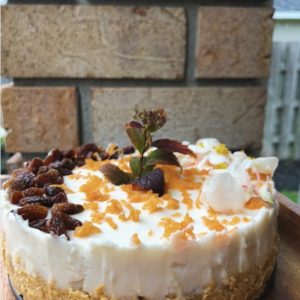
Vegan Carrot Cake Recipe (Raw Carrot & Coconut)
Equipment
- Springform Cake Pan 7-inch diameter
- High-speed blender or large bowl food processor
Ingredients
For the Carrot Base Layer
- 1 cup finely shredded carrot ~1 large, fresh carrot
- 1 cup soft Medjool dates pitted
- ½ cup raw walnuts
- ¾ cup dry rolled oats
- 1 tsp vanilla extract
- ⅛ tsp pink salt
- ¾ tsp ground cinnamon
- ¼ tsp ground ginger
- ¼ cup coconut flour
- 3 tbsp plump black raisins
For the Coconut Top Layer
- 1 can full-fat coconut milk, using only the cream see section on Wet Ingredients above for how to make coconut cream from a can of coconut milk
- ¼ cup pure maple syrup
- 1 tsp vanilla extract
Instructions
For the Carrot Base Layer
- For the first layer, blend together all carrot layer ingredients, except the raisins and the coconut flour, until smooth. Once this mixture is smooth, mix in the coconut flour and raisins by hand.
- Use a piece of parchment paper or lightly oil the base with melted coconut oil (use refined coconut oil, which should smell neutral. Not virgin or extra-virgin). This will help to avoid the dough sticking to the base of the cake pan.
- Now pat the carrot mixture down into the prepared pan.
For the Coconut Top Layer
- For the second layer, use a hand mixer to whip together all the coconut layer ingredients until they're smooth and fluffy, like buttercream frosting.
- Pour this on top of the carrot layer, then put in the freezer to harden for 4-5 hours. If you want to add flowers or other things as topping, I suggest it should be done before the cake goes in the freezer.
- Once it is frozen, remove from the freezer and take off the sides of the cake pan. Allow the cake to thaw for a few minutes before cutting. Use a knife run under boiling hot water for a clean cut. Enjoy!
Notes
-
Storage
- Store in an airtight container in the freezer for up to one week.
- Based off this recipe
